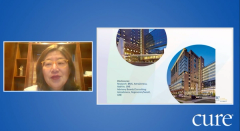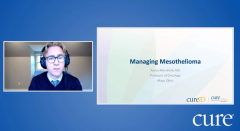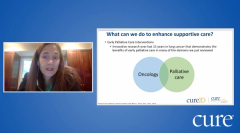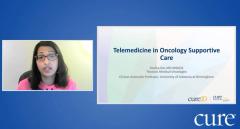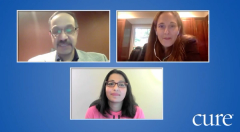
Educated Patient® Lung Cancer Summit Telemedicine in Oncology Supportive Care Presentation: October 1, 2022
Watch Dr. Devika Das, from University of Alabama at Birmingham Medicine, discuss the benefits of telemedicine in cancer care during the CURE® Educated Patient® Lung Cancer Summit.
Episodes in this series

From cutting costs to protecting fragile immune systems, telemedicine (the use of technology to administer health care remotely) can provide an array of benefits to patients with cancer but more must be done to improve and ensure access, according to an expert.
During CURE®’s Educated Patient® Lung Cancer Summit, Dr. Devika Das, a thoracic medical oncologist and clinical associate professor at University of Alabama at Birmingham Medicine, highlighted the benefits of telemedicine, its rapid growth during the COVID-19 pandemic, the barriers that must be broken to increase accessibility and the importance of maintaining legislative support for telehealth.
Bridging Gaps in Accessibility
Das explained that while there have been significant advances in the treatment of the disease, not all patients with lung cancer have benefitted from these developments.
She noted that geographic location can prevent patients from accessing care, mentioning that patients who reside in rural areas may not have the same access to treatment as patients who live near academic centers.
But telemedicine, according to Das, can bridge these gaps, however it needs to be patient-centered.
Understanding the Roots of Telemedicine
Das explained that the United States Department of Veterans Affairs (VA) has been at the “forefront” of providing telemedicine to patients with cancer. In fact, the VA’s National Oncology Program has recently launched a new program, National TeleOncology (NTO), which has the goal of increasing veteran’s access to oncology care, with a focus on veterans residing in rural areas.
Das noted that since 66% of U.S. rural counties do not have an oncologist, this program can showcase the benefits of telemedicine.
“If we can (implement telemedicine) at the VA,” Das stressed, “we can do this broadly and we can do this globally.”
COVID-19 Pandemic Triggers Rapid Adoption
Before the COVID-19 pandemic, it was difficult to implement telemedicine into health care, according to Das.
However, it was unsafe for patients with cancer to travel for appointments because of compromised immune systems. Of note, according to Das, there was a 154% increase in remote clinical care between March 2019 and March 2020.
Cutting Out Unnecessary Visits
Telemedicine allows patients with cancer in rural parts of the country to know if they are eligible to participate in clinical trials located far away from their community without having to travel there, according to Das.
It also makes it easier for the patients’ caregivers to participate and ask any questions before trial enrollment. Das also pointed out that patients with cancer can easily ask questions about chemotherapy, inform doctors of symptoms and discuss imaging studies during remote clinical care. The objective of telemedicine for patients with cancer, Das noted in her presentation, is to ensure that “patients are not coming for a visit … unless they need to.”
Improving Financial and Mental Health
Das explained that patients with cancer may feel overwhelmed with all the new information they are given after their diagnosis and can become distressed. Telemedicine, however, can make it easier for a patient to work with their doctor to reduce anxiety levels.
Not only are cancer drugs expensive but going to in-person cancer appointments can lead to lost pay due to missing work. Moreover, patients may be faced with the cost of transportation and parking as well as finding childcare. Instead, Das explained, telemedicine can reduce these expenses and possibly alleviate some of the financial toxicity patients may face.
A “Digital Divide” Poses Barriers
Despite the benefits of telemedicine there are many barriers that prevent all patients with cancer from accessing this type of appointment, according to Das. One of the reasons patients have limited access, Das noted, is that some patients do not have smartphones and lack uninterrupted broadband access.
Additionally, Das further explained that older patients have physical restrictions such as arthritis and visual disabilities that make it hard for them to operate devices that can connect to the internet. Furthermore, some patients have been slow to adapt to telemedicine and do not consider remote appointments an acceptable alternative to in-person visits with the doctor. Das stressed the importance of overcoming these barriers, explaining that, “we have to, as a medical community, work (to) ensure that the delivery of telemedicine is … equitable and not widen this digital divide.”
For more news on cancer updates, research and education, don’t forget to

